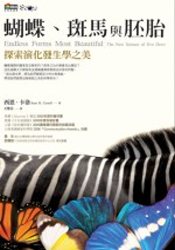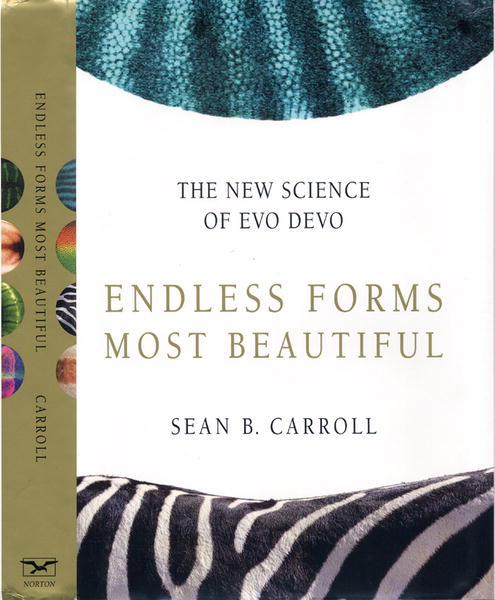






《蝴蝶、斑馬與胚胎:探索演化發生學之美》(Endless Forms Most Beautiful: The New Science of Evo Devo)這本書,基本上要試著深討,生物形態的多樣性,像是蝴蝶翅斑的繽紛多彩,是經由何種遺傳變化而產生的,並且介紹一個新的領域給大眾。
英文書名Endless Forms Most Beautiful是取自達爾文(Charles R. Darwin, 1809-1882)在《物種起源》(The Origin of Species)中的結語:「from so simple a beginning, endless forms most beautiful and most wonderful have been, and are being, evolved.」
這本書在台灣應該沒多少人比我更有資格寫介紹和書評了,因為我基本上就是作者Sean Carroll的徒孫,我博士班老闆Artyom Kopp曾在Sean Carroll的實驗室裡當過博士後研究員,而我是我老闆的大弟子,最近準備趁論文委員搞清楚狀況前,趁機把論文交出去。我今天早上還和Sean Carroll聊了一下,他今天下午和明天中午在學校各有一場演講。
不過,我原本其實不太想寫《蝴蝶、斑馬與胚胎》這本書的書評,原因不是因為它不是本好書,它是本很不錯的科普書,可是卻也是本頗有點誤導性的書。而且也很可惜的,這本書的中譯版似乎出現了一些重大誤譯,關於這一點,就參考纖毛蟲兄的〈「工具組主控基因」?〉。
Sean Carroll是Evo Devo(演化發生學或演化發育生物學)這個領域的開山祖師之一,他在2005年當選美國國家科學院(National Academy of Sciences)院士,實在是實至名歸。Sean Carroll不僅開創了Evo Devo,我還敢說他是Evo Devo這個領域裡最聰明的人之一,因為他走的方向最正確,研究成果產量也最豐盛,徒子徒孫開始遍布各大學名校,而且他也是少數能把演化理論掌握得相當好的發育生物學家。除此之外,他也是很熱心的教育家,出版了好幾本科普書,並且到處進行精彩的通俗和學術演講。
Evo Devo說簡單些,就是試圖利用發育生物學的方法,來解釋形態的演化。而這個領域,並不是由Sean Carroll一人開創的,意識到發育生物學的方法,是解釋形態演化的好方法而作出很大貢獻的科學家,有名的至少就有一兩打。不過在書中,Sean Carroll雖然很清楚地交待了Evo Devo究竟是啥,也對動物的發育機制作了很深入淺出的介紹,可是略嫌不足的是,書中舉出的例子,大多數是他實驗室的成果,對整個Evo Devo的進展,介紹得不夠全面。
不過,《蝴蝶、斑馬與胚胎:探索演化發生學之美》算是第一本介紹Evo Devo的科普書,也是一本寫得很好的科普書了。如果真的對Evo Devo有興趣,現在絕大部分的演化生物學和發育生物學的教科書,對Evo Devo都有至少一章作基本的介紹,而Sean Carroll等人合著的教科書From DNA to Diversity: Molecular Genetics and the Evolution of Animal Design,也對Evo Devo作了相當全面的介紹。
如果想要深入研究這個領域,除了這本必讀的書還有好幾本好書可以讀一讀,有另一本相當不錯的科普書Your Inner Fish: A Journey into the 3.5-Billion-Year History of the Human Body by Neil Shubin。很多Evo Devo的評論文章,會提到已故的哈佛演化學大師Stephen Jay Gould在1985年出版的Ontogeny and Phylogeny,許多Evo Devo的開山祖師,也是受到該書的啟發,而從發育生物學走進演化生物學的,或者從演化生物學走向發育生物學的。
達爾文在提出演化理論時,並沒有所謂的遺傳學,孟德爾遺傳學一直要到廿世紀初才被重新發現,可是沒有遺傳學的基礎,根本解釋不了達爾文理出的天擇理論。而現代演化綜合理論(Modern evolutionary synthesis)在廿世紀的發展,就是要把新發展的遺傳學原理,加上分類學、動物學、植物學、細胞學、生理學、古生物學、行為學、生態學以及生物地理學等等的發現和理論,結合到演化理論裡去,使得演化生物學幾乎涵蓋了整個生命科學的所有領域。然而很不巧的,發育生物學被一整個地遺忘了。
Ernst Haeckel早在1866年就提出「重演說」(ontogeny recapitulates phylogeny)的理論,嘗試用胚胎學的方法來解釋形態演化,D'Arcy Thompson在1917年出版的書On Growth and Form也提示形態變化興發育過程的關係。不過「重演說」後來被證實是錯的,在基因被發現後,胚胎學有好幾十年被生物學家遺忘。Stephen Jay Gould在胚胎學被遺忘了好幾十年後,在Ontogeny and Phylogeny提出,許多生物形態上的演化,是源自胚胎發育的異時性(heterochrony),例如幼態延續(neoteny)。基本上,人類就是猿類的幼態延續,在發育生物學上,人類是早產兒,成人在形態和生理上,是黑猩猩的幼態,這也是為何人類可以在出生後,需要被父母照料很長的時間,並且持續學習。
Stephen Jay Gould讓早被遺忘的胚胎學在演化生物學中重現光芒。發育生物學的發展,讓它不僅是對胚胎發育的形態描述而已,而有了堅實的分子生物學及遺傳學基礎。加上Hox基因的發現,對發育生物學家來說是個震撼彈,因為幾乎所有動物,不管有多簡單或者在形態上差異多大,幾乎全都使用同一組Hox基因在調控體節的發育。Hox基因,基本上是調控體節的特性,也就是調控不同的體節該長出什麼器官構造。不同門類的動物,從線蟲到果蠅到人類,基本上由同一組基因來調節體節的發育,對發育生物學家來說,簡直就是天方夜譚。為了解釋這一點,引導了許多發育生物學家投入演化生物學的研究。
對演化生物學產生興趣的發育生物學家,除了Sean Carroll之外,還有Caltech的Eric Davidson、UC Berekely的Mike Levine和John Gerhart,哈佛的Marc Kirschner等,還有古生物學家James Valentine,和演化生態學家Mary Jane West-Eberhard,都試圖對用發育生物學的方法來解釋生物形態的演化(Eric Davidson和我在清大的老闆李家維老師有些合作)。他們都是國家科學院院士,已經掌握有一定的研究資源,可是我老闆說Sean Carroll剛出道時,路程其實是非常艱辛的。
據說Sean Carroll幾乎不曾拿過美國國家衛生研究院(NIH)的研究經費,因為他的申請計劃,對發育生物學家來說,應用非模式生物來作發育生物學的研究,幾乎是不可能的任務(我們實驗室的計劃最近也還被評審用同樣的理由打回票);而對演化生物學家來說,Evo Devo的研究像是在胚胎上畫線(我老闆在這裡應徵教職時,系上一個大佬還用同樣的評語來嘲諷他,雖然我老闆的研究已經算是有相當紮實的遺傳學基礎)。
還好美國的生物醫學慈善機構Howard Hughes Medical Institute(簡稱HHMI)對Sean Carroll大力贊助,要不然這Evo Devo的許多具體成果迄今都不可能取得。HHMI是美國一個非營利性醫學研究所。是由著名航空鉅子Howard Robard Hughes, Jr.(1905-1976)於1953年成立的。 截至2005年底為止,它是美國規模最大的私人資金資助生物和醫學研究的組織之一,僅次於比爾與梅林達蓋茨基金會。由李奧納多‧狄卡皮歐(Leonardo DiCaprio)主演的電影《神鬼玩家》(The Aviator, 2004),就是講述Howard Hughes的一生。
HHMI的研究員基本上遍布美國各研究型大學,他們的贊助是對人而不對計劃,意即只要能當上HHMI的研究員,就會拿到一大筆經費,隨他們自行決定要執行哪些計劃,所以HHMI的研究員常常能有足夠的資源開創出新的領域,而不需要擔心他們的新點子是否討喜。
於是Sean Carroll的研究計劃雖然很不討喜,不過在HHMI的大方大力贊助之下,他再也不需要擔心經費的問題而盡全力建立Evo Devo這個新領域。除了Sean Carroll,HHMI也贊助了另一位Evo Devo的建立者Nipham Patel,他原本在芝加哥大學,前幾年搬到UC Berkeley,他很有心地每隔一年辦一個小型研討會,我去過兩次,收獲頗豐盛。除此之外,HHMI的前研究員Thomas Kaufman,是果蠅發育生物學的大佬,他也做了一些些Evo Devo方面的研究。HHMI在史丹福大學的研究員David M. Kingsley,對三棘魚的演化發育也有很深入的研究。HHMI最近也入選了普林斯頓大學的David L. Stern,他在果蠅做的幾項微觀演化之遺傳基礎的研究,是經典之作,讓Evo Devo有了堅實的遺傳學基礎,他對蚜蟲的演化和發育研究很深入,將來肯定大有可為。
Evo Devo在我來唸研究所時,還算是有點新的領域,可是在這幾年已經漸漸成為主流了。像我之前提到的,有些演化生物學家,尤其是族群遺傳學家,對Evo Devo是相當不屑的。因為他們認為Evo Devo沒有紮實的遺傳學基礎,尤其是當比較不同門網目的生物時,Evo Devo用的方法主要是利用抗體來標示基因表現的差異,來支持基因表現之差異是生物形態差異之遺傳基礎。這樣的研究方法,就是所謂的「在胚胎上畫線」。Sean Carroll算是個中佼佼者,有一個原因是他選用的物種,例如果蠅等,是能夠進行紮實的遺傳實驗室。而且,如果選用近緣種,就算不是模式生物,也還是能夠進行紮實的遺傳實驗,所以就不只是胚胎上畫線了。
而有些發育生物學家和細胞生物學家想要漟演化生物學的渾水,可是他們對演化理論掌握得並不是很精確。我們系上一位族群遺傳學的大佬,對分子和細胞生物學很熟悉,他當聽完一些演講,就指出有些分子和細胞生物學家,想把他們的研究扯上演化,可是他們卻犯最基本的錯,例如連演化樹都亂畫等。John Gerhart和 Marc Kirschner的書The Plausibility of Life: Resolving Darwin's Dilemma,就被演化生物學家捉出對演化理論的誤解等(Brian Charlesworth (2005) On the Origins of Novelty and Variation, Science, 9 Dec 2005, pp.1619-1620.)。
不過,許多族群遺傳學家和數量遺傳學家,對Evo Devo感冒的一點還有,Evo Devo的理論中,不同門的動物之間的差異,不能夠用累積的小變化來解釋,於是提出在保守的發育基因中產生的大突變才有辦法解釋其中的巨大個體變化。可是,我們系上一個族群遺傳學大佬,在上課時就表示他不相信那一套。他相信累積的小突變就能夠解釋不同門動物的形態差異,只是那些中間過程發生在好幾億年前,而中間過程中產生的個體並沒有留下化石。舉個例子,小如吉娃娃,大如秋田犬,不同體型形態的狗,在短短的幾百年內就被育種出來,幾億幾千萬年的時間,是有可能累積足夠的小遺傳變化的而導致形態上的巨大變化。
雖然族群遺傳學家不相信這一套,不過他們基本上也只是抱著井水不犯河水的態度私底下嘲諷。一直到前幾年,筆戰才在學術期刊中打起來。首是Eric Davidson和Douglas Erwin在期刊Science發表一篇評論Gene regulatory networks and the evolution of animal body plans,接著芝加哥大學的Jerry Coyne直接對該篇文章開炮,指稱他們犯了許多重大錯誤。
Jerry Coyne非常有名,他是研究種化遺傳(The genetics of speciation)的權威,他和H. Allen Orr合寫的書Speciation,是這個領域的經典。Jerry Coyne早年曾在我們學校待過,和系上大佬們交情很好。他絕頂聰明,學術文章和書籍都寫得非常棒,他還是個超級工作狂,每天早上六點半就進實驗室,一直不停地工作到下午五點半走人。他在今年1月出版了本科普書Why Evolution Is True,應該會是本介紹演化生物學不可多得的好書。他還喜歡在期刊上發文指出其他演化研究或理論的疏失,也不管是不是他的領域,我老闆就曾吃過他的虧。
Eric Davidson據說是脾氣火暴出名的,也發了了一篇很不客氣的回文,不過那幾篇文章還不至於有太大的影響。直到前年中,Jerry Coyne和哈佛的Hopi Hoekstra在期刊Evolution發了一篇長文The locus of evolution: evo devo and the genetics of adaptation,根本就是要單挑Sean Carroll,把論戰白熱化。他們在文章中,多次直接引用Sean Carroll在Endless Forms Most Beautiful和From DNA to Diversity中的文句,然後在下面用語調極不客氣的話幹譙他的論點。Jerry Coyne雖然是機車出名的,可是Hopi Hoekstra卻看不出來。她幾年前曾到我們學校給了幾場演講,她看來為人十分和善,完全看不出會寫出那麼機車的文章。那篇文章真的很嚇人,是我讀過語氣最惡劣的學術文章!基本上,如果把那些文句翻成白話文,就是:「Sean Carroll,你是隻連常識都沒有的大笨豬!」。
據我老闆說,Sean Carroll是氣炸了。原本我以為很快就有好戲可以看,Sean Carroll一定會很快地在期刊發文章把Jerry Coyne痛扁一頓。可是等了一年多,才在期刊Cell看到Sean Carroll對Jerry Coyne等人的文章作間接回應的文章Evo-devo and an expanding evolutionary synthesis: a genetic theory of morphological evolution。我問老闆,他說Sean Carroll雖然氣炸,可是他決定沈寂一陣,等情緒平復了,才理性地對Jerry Coyne的指控作回復。這段故事,前陣子在期刊Science有篇報導(Evolutionary biology. Deciphering the genetics of evolution. Pennisi E. Science. 2008 Aug 8;321(5890):760-3.)。
而Jerry Coyne等人指控Sean Carroll的,是Sean Carroll提出,生物形態變化,主要是源自基因調控區域的變化,而非造成蛋白質序列變化的遺傳改變之理論。基本上,這個理論也是Evo Devo的核心理論。Sean Carroll等人指出,基因調控區域的變化過去在演化遺傳學的研究中長期被忽略,原因不外是族群遺傳學家和分子演化學家柿子挑軟的吃。蛋白質的改變比較容易研究,所以長期成為演化遺傳學的主流。可是,Sean Carroll等人要指出,基因調控區域的變化才是真正的王道。他在書中,和演講中都一直強調這一點。
基因調控區域的變化是生物形態演化的主要遺傳根源,並不僅是現今主要的證據都相當支持這一點,還有理論的根據。許多基因,是有多效性的(pleiotropic),破壞了基因的功能,會產生多種不同的表型。最典型的例子是人類的疾病苯丙酮尿症(PKU)。PKU是一種可遺傳的胺基酸代謝缺陷,患者肝臟中缺乏苯丙氨酸(Phenylalanine)羥化酶,使得食物中的苯丙氨酸無法轉化為酪氨酸(Tyrosine),結果導致大腦內苯丙氨酸聚集,經轉氨酶的作用轉化為苯丙酮酸,從而影響患者的大腦發育,引起智力障礙和癲癇,並使患者出現皮膚白化、頭髮變黃、尿液有鼠臭味等徵狀。
而調控發育過程的基因,大多是編碼轉錄因子(transcription factors)的,它們調控的下遊基因很多,在蛋白質序列內發生的突變,會導致嚴重的後果。可是發生在基因調控區域的突變,可能只是改變它們在不同的組織器官,或者在不同時間點的表現之變化,對生物體整體的影響較有限,當那樣的小變化產生時,正好對該個體有利,則該突變就會被選擇性地保留下來。
可是Jerry Coyne等人卻不吃這套,他們在文章中指出Sean Carroll選擇性引用論文,並且扭曲一些研究結果,還有過度簡化結論,試圖對科學界及大眾進行誤導!而且他們對Sean Carroll忽略新基因或複本基因的貢獻,也相當感冒。然而Jerry Coyne和Hopi Hoekstra,也不見得沒有偏見。Hopi Hoekstra的經典研究是野鼠的毛色演化,她所發現的基因,產生的變化是發生在蛋白質序列的,所以她自然不認為基因調控區域的變化比較重要。
不過,他們的論點中有道理的地方在,現在其實還沒有足夠多的證據指出基因調控區域的變化真的比較重要,而且Sean Carroll指出生理變化的遺傳基礎主要在於蛋白質序列變化,也不一定能說得通,因為生理和形態有時候是一體的兩面。而過度簡化的指控,雖然不是沒有道理,不過在推廣新理論時,某些程度的過度簡化其實是必要之惡。
在Jerry Coyne和Hopi Hoekstra那篇文章後,Eric Davidson和Douglas Erwin在期刊Nature Reviews Genetics發了一篇文章對他們的理論作進一步的修正,David Stern等人也分別在期刊Evolution和Science中各發一篇文章闡釋基因調控區域變化的重要性。不過,依我來看,這場論戰可能還會持繼一陣。
其實,科學家都是柿子挑軟的吃的啦。族群生物學家研究蛋白質序列變化,是因為比較簡單。而發育生物學家愛研究基因表現的變化,也是因為有現成的工具。相甭提大家都挑容易在實驗室裡被飼養,還有遺傳工具可用的動植物。所以,現在所有的研究,都是帶著偏見進行的,而且大部分算是個案研究。所以在大規模、系統性的研究出現前,都還無法蓋棺定論,在未來十年內,這還會是一個重要的問題吧。
好吧,我接下來的學術生涯,或許會朝著解決這個問題的目標前進吧,請大家拭目以待:)
Sean Carroll還著有兩本科普好書:The Making of the Fittest: DNA and the Ultimate Forensic Record of Evolution、Into The Jungle: Great Adventures in the Search for Evolution和Remarkable Creatures: Epic Adventures in the Search for the Origins of Species,以後有機會再介紹。
想進一步瞭解Evo Devo而英文聽力不錯的朋友,可以觀看HHMI的2005年假日講習系列:
還有Sean Carroll去年的這場演講:
對Evo Devo有興趣想深入瞭解的朋友,可以參考其他較為深入的書:
The Shape of Life: Genes, Development, and the Evolution of Animal Form by Rudolf A. Raff
The Regulatory Genome: Gene Regulatory Networks In Development And Evolution by Eric H. Davidson
The Origin of Animal Body Plans: A Study in Evolutionary Developmental Biology by Wallace Arthur
The Evolution of Developmental Pathways by A. S. Wilkins
The Plausibility of Life: Resolving Darwin's Dilemma和Cells, Embryos, and Evolution: Toward a Cellular and Developmental Understanding of Phenotypic Variation and Evolutionary Adaptability by Marc W. Kirschner和John C. Gerhart
Developmental Plasticity and Evolution by Mary Jane West-Eberhard
Modularity in Development and Evolution by Gerhard Schlosser
On the Origin of Phyla by James W. Valentine
還有以下期刊評論論文,順序依刊出日期排列,個人認為必讀的用粗體標出:
On the architecture of regulatory systems: evolutionary insights and implications.
Dickinson WJ.
Bioessays. 1988 Jun;8(6):204-8.
Hox and HOM: homologous gene clusters in insects and vertebrates.
Akam M.
Cell. 1989 May 5;57(3):347-9.
The evolving role of Hox genes in arthropods.
Akam M, Averof M, Castelli-Gair J, Dawes R, Falciani F, Ferrier D.
Dev Suppl. 1994:209-15.
Developmental evolution: new paradigms and paradoxes.
Wray GA.
Dev Genet. 1994;15(1):1-6.
Developmental evolution: insights from studies of insect segmentation.
Patel NH.
Science. 1994 Oct 28;266(5185):581-90.
Molecules and morphology: where's the homology?
Dickinson WJ.
Trends Genet. 1995 Apr;11(4):119-21.
Hox genes and the evolution of diverse body plans.
Akam M.
Philos Trans R Soc Lond B Biol Sci. 1995 Sep 29;349(1329):313-9.
Neo-Darwinian developmental evolution: can we bridge the gap between pattern and process?
Palopoli MF, Patel NH.
Curr Opin Genet Dev. 1996 Aug;6(4):502-8.
Resynthesizing evolutionary and developmental biology.
Gilbert SF, Opitz JM, Raff RA.
Dev Biol. 1996 Feb 1;173(2):357-72.
Hox genes and chordate evolution.
Holland PW, Garcia-Fernàndez J.
Dev Biol. 1996 Feb 1;173(2):382-95.
Growing pains: evo-devo researchers straddle cultures.
Roush W, Pennisi E.
Science. 1997 Jul 4;277(5322):38-9.
Homology and developmental genes.
Abouheif E, Akam M, Dickinson WJ, Holland PW, Meyer A, Patel NH, Raff RA, Roth VL, Wray GA.
Trends Genet. 1997 Nov;13(11):432-3.
Set-aside cells in maximal indirect development: evolutionary and developmental significance.
Peterson KJ, Cameron RA, Davidson EH.
Bioessays. 1997 Jul;19(7):623-31.
The Yin and Yang of Evo/Devo.
Akam M.
Cell. 1998 Jan 23;92(2):153-5.
Hox genes, homeosis and the evolution of segment identity: no need for hopeless monsters.
Akam M.
Int J Dev Biol. 1998;42(3):445-51.
Understanding the genetic basis of morphological evolution: the role of homeotic genes in the diversification of the arthropod bauplan.
Popadić A, Abzhanov A, Rusch D, Kaufman TC.
Int J Dev Biol. 1998;42(3):453-61.
Molecular evolution of the brain of chordates.
Williams NA, Holland PW.
Brain Behav Evol. 1998;52(4-5):177-85.
Shaping animal body plans in development and evolution by modulation of Hox expression patterns.
Gellon G, McGinnis W.
Bioessays. 1998 Feb;20(2):116-25.
Hox genes: from master genes to micromanagers.
Akam M.
Curr Biol. 1998 Sep 24;8(19):R676-8.
Hox genes in arthropod development and evolution.
Akam M.
Biol Bull. 1998 Dec;195(3):373-4.
When is homology not homology?
Wray GA, Abouheif E.
Curr Opin Genet Dev. 1998 Dec;8(6):675-80.
The evolution of the Hox cluster: insights from outgroups.
Finnerty JR, Martindale MQ.
Curr Opin Genet Dev. 1998 Dec;8(6):681-7.
Evolvability.
Kirschner M, Gerhart J.
Proc Natl Acad Sci U S A. 1998 Jul 21;95(15):8420-7.
Selector genes and limb identity in arthropods and vertebrates.
Weatherbee SD, Carroll SB.
Cell. 1999 Apr 30;97(3):283-6.
Early animal evolution: emerging views from comparative biology and geology.
Knoll AH, Carroll SB.
Science. 1999 Jun 25;284(5423):2129-37.
The origin and evolution of segmentation.
Davis GK, Patel NH.
Trends Cell Biol. 1999 Dec;9(12):M68-72.
Evolutionary dissociations between homologous genes and homologous structures.
Wray GA.
Novartis Found Symp. 1999;222:189-203; discussion 203-6.
The effect of gene duplication on homology.
Holland PW.
Novartis Found Symp. 1999;222:226-36; discussion 236-42.
Introduction: gene duplication in development and evolution.
Holland PW.
Semin Cell Dev Biol. 1999 Oct;10(5):515-6.
Gene duplication: past, present and future.
Holland PW.
Semin Cell Dev Biol. 1999 Oct;10(5):541-7.
Vertebrate genomics: More fishy tales about Hox genes.
Meyer A, Málaga-Trillo E.
Curr Biol. 1999 Mar 25;9(6):R210-3.
Homology and homoplasy: the retention of genetic programmes.
Meyer A.
Novartis Found Symp. 1999;222:141-53; discussion 153-7.
Chronicling the birth of a discipline.
Raff RA, Arthur W, Carroll SB, Coates MI, Wray G.
Evol Dev. 1999 Jul-Aug;1(1):1-2.
Synthesizing evolution, bird by bird.
Carroll SB.
Evol Dev. 1999 Sep-Oct;1(2):73.
Gene and genome duplications in vertebrates: the one-to-four (-to-eight in fish) rule and the evolution of novel gene functions.
Meyer A, Schartl M.
Curr Opin Cell Biol. 1999 Dec;11(6):699-704.
Developmental patterning genes and their conserved functions: from model organisms to humans.
Veraksa A, Del Campo M, McGinnis W.
Mol Genet Metab. 2000 Feb;69(2):85-100.
Bilaterian origins: significance of new experimental observations.
Peterson KJ, Cameron RA, Davidson EH.
Dev Biol. 2000 Mar 1;219(1):1-17.
Regulatory evolution and the origin of the bilaterians.
Peterson KJ, Davidson EH.
Proc Natl Acad Sci U S A. 2000 Apr 25;97(9):4430-3.
Vertebrate innovations.
Shimeld SM, Holland PW.
Proc Natl Acad Sci U S A. 2000 Apr 25;97(9):4449-52.
Endless forms: the evolution of gene regulation and morphological diversity.
Carroll SB.
Cell. 2000 Jun 9;101(6):577-80.
Evolutionary developmental biology and the problem of variation.
Stern DL.
Evolution. 2000 Aug;54(4):1079-91.
Evo-devo: the evolution of a new discipline.
Raff RA.
Nat Rev Genet. 2000 Oct;1(1):74-9.
Beyond the Hox complex.
Patel NH, Prince VE.
Genome Biol. 2000;1(5):REVIEWS1027. Epub 2000 Nov 8.
The evolution of embryonic patterning mechanisms in animals.
Wray GA.
Semin Cell Dev Biol. 2000 Dec;11(6):385-93.
Molecular genetics of crustacean feeding appendage development and diversification.
Browne WE, Patel NH.
Semin Cell Dev Biol. 2000 Dec;11(6):427-35.
Conservation and divergence in molecular mechanisms of axis formation.
Lall S, Patel NH.
Annu Rev Genet. 2001;35:407-37.
Ancient origin of the Hox gene cluster.
Ferrier DE, Holland PW.
Nat Rev Genet. 2001 Jan;2(1):33-8.
The big picture.
Carroll SB.
Nature. 2001 Feb 8;409(6821):669.
Chance and necessity: the evolution of morphological complexity and diversity.
Carroll SB.
Nature. 2001 Feb 22;409(6823):1102-9.
Developmental system drift and flexibility in evolutionary trajectories.
True JR, Haag ES.
Evol Dev. 2001 Mar-Apr;3(2):109-19.
Perspective: From mutants to mechanisms? Assessing the candidate gene paradigm in evolutionary biology.
Haag ES, True JR.
Evolution. 2001 Jun;55(6):1077-84.
Beyond the Hox: how widespread is homeobox gene clustering?
Holland PW.
J Anat. 2001 Jul-Aug;199(Pt 1-2):13-23.
Bridging the gap between developmental systems theory and evolutionary developmental biology.
Robert JS, Hall BK, Olson WM.
Bioessays. 2001 Oct;23(10):954-62.
Toward a new synthesis: population genetics and evolutionary developmental biology.
Johnson NA, Porter AH.
Genetica. 2001;112-113:45-58.
Evolution of the organizer and the chordate body plan.
Gerhart J.
Int J Dev Biol. 2001;45(1):133-53.
Short, long, and beyond: molecular and embryological approaches to insect segmentation.
Davis GK, Patel NH.
Annu Rev Entomol. 2002;47:669-99.
The last common bilaterian ancestor.
Erwin DH, Davidson EH.
Development. 2002 Jul;129(13):3021-32.
The emerging conceptual framework of evolutionary developmental biology.
Arthur W.
Nature. 2002 Feb 14;415(6873):757-64.
Evo-devo graduates to new levels.
Tautz D.
Trends Genet. 2002 Feb;18(2):66-7.
Evolution of developmental diversity. Evo-devo devotees eye ocular origins and more.
Pennisi E.
Science. 2002 May 10;296(5570):1010-1.
The genetics and evo-devo of butterfly wing patterns.
Beldade P, Brakefield PM.
Nat Rev Genet. 2002 Jun;3(6):442-52.
Evo-devo comes into focus.
Babbitt C, Giorgianni M, Price A.
Bioessays. 2002 Jul;24(7):677-9.
The Radiata and the evolutionary origins of the bilaterian body plan.
Martindale MQ, Finnerty JR, Henry JQ.
Mol Phylogenet Evol. 2002 Sep;24(3):358-65.
Phylogeny, fossils, and model systems in the study of evolutionary developmental biology.
Santini F, Stellwag EJ.
Mol Phylogenet Evol. 2002 Sep;24(3):379-83.
Molecular mechanisms of selector gene function and evolution.
Mann RS, Carroll SB.
Curr Opin Genet Dev. 2002 Oct;12(5):592-600.
Hox genes and the evolution of the arthropod body plan.
Hughes CL, Kaufman TC.
Evol Dev. 2002 Nov-Dec;4(6):459-99.
Gene co-option in physiological and morphological evolution.
True JR, Carroll SB.
Annu Rev Cell Dev Biol. 2002;18:53-80. Epub 2002 Apr 2.
Evolutionary biology. Evo-devo enthusiasts get down to details.
Pennisi E.
Science. 2002 Nov 1;298(5595):953-5.
Modelling 'evo-devo' with RNA.
Fontana W.
Bioessays. 2002 Dec;24(12):1164-77.
Evolution of development in closely related species of flies and worms.
Simpson P.
Nat Rev Genet. 2002 Dec;3(12):907-17.
The morphogenesis of evolutionary developmental biology.
Gilbert SF.
Int J Dev Biol. 2003;47(7-8):467-77.
Evolution of transcription factor function.
Hsia CC, McGinnis W.
Curr Opin Genet Dev. 2003 Apr;13(2):199-206.
Genetics and the making of Homo sapiens.
Carroll SB.
Nature. 2003 Apr 24;422(6934):849-57.
Knowing your ancestors: themes in the history of evo-devo.
Love AC, Raff RA.
Evol Dev. 2003 Jul-Aug;5(4):327-30.
Transcription regulation and animal diversity.
Levine M, Tjian R.
Nature. 2003 Jul 10;424(6945):147-51.
Evolution in black and white: genetic control of pigment patterns in Drosophila.
Wittkopp PJ, Carroll SB, Kopp A.
Trends Genet. 2003 Sep;19(9):495-504.
The evolution of transcriptional regulation in eukaryotes.
Wray GA, Hahn MW, Abouheif E, Balhoff JP, Pizer M, Rockman MV, Romano LA.
Mol Biol Evol. 2003 Sep;20(9):1377-419. Epub 2003 May 30.
Perspective: Evolution and detection of genetic robustness.
de Visser JA, Hermisson J, Wagner GP, Ancel Meyers L, Bagheri-Chaichian H, Blanchard JL, Chao L, Cheverud JM, Elena SF, Fontana W, Gibson G, Hansen TF, Krakauer D, Lewontin RC, Ofria C, Rice SH, von Dassow G, Wagner A, Whitlock MC.
Evolution. 2003 Sep;57(9):1959-72.
Evo-Devo: evolutionary developmental mechanisms.
Hall BK.
Int J Dev Biol. 2003;47(7-8):491-5.
Transcriptional regulation and the evolution of development.
Wray GA.
Int J Dev Biol. 2003;47(7-8):675-84.
The place of phylogeny and cladistics in Evo-Devo research.
Telford MJ, Budd GE.
Int J Dev Biol. 2003;47(7-8):479-90.
More genes in vertebrates?
Holland PW.
J Struct Funct Genomics. 2003;3(1-4):75-84.
The evolution of multicellularity and early animal genomes.
Brooke NM, Holland PW.
Curr Opin Genet Dev. 2003 Dec;13(6):599-603.
Evolutionary genetics: the nature of hidden genetic variation unveiled.
Wagner GP.
Curr Biol. 2003 Dec 16;13(24):R958-60.
Evo-devo aspects of classical and molecular data in a historical perspective.
Sander K, Schmidt-Ott U.
J Exp Zoolog B Mol Dev Evol. 2004 Jan 15;302(1):69-91. Erratum in: J Exp Zoolog Part B Mol Dev Evol. 2004 May 15;302(4):341.
Beyond Arabidopsis. Translational biology meets evolutionary developmental biology.
Irish VF, Benfey PN.
Plant Physiol. 2004 Jun;135(2):611-4.
The gain in the brain is plain when evo meets devo.
Reiner A, Wullimann MF.
Bioessays. 2004 Sep;26(9):1026-30.
The evolution of arthropod segmentation mechanisms.
Peel A.
Bioessays. 2004 Oct;26(10):1108-16.
Evo-devo perspectives on segmentation: model organisms, and beyond.
Minelli A, Fusco G.
Trends Ecol Evol. 2004 Aug;19(8):423-9.
Hemichordates and the origin of chordates.
Gerhart J, Lowe C, Kirschner M.
Curr Opin Genet Dev. 2005 Aug;15(4):461-7.
Evolution at two levels: on genes and form.
Carroll SB.
PLoS Biol. 2005 Jul;3(7):e245. Epub 2005 Jul 12.
The evolution of homeobox genes: Implications for the study of brain development.
Holland PW, Takahashi T.
Brain Res Bull. 2005 Sep 15;66(4-6):484-90.
Phylogeny and evo-devo: characters, homology, and the historical analysis of the evolution of development.
Cracraft J.
Zoology (Jena). 2005;108(4):345-56. Epub 2005 Oct 11.
The molecular elements that underlie developmental evolution.
Alonso CR, Wilkins AS.
Nat Rev Genet. 2005 Sep;6(9):709-15.
Duplication events and the evolution of segmental identity.
Hurley I, Hale ME, Prince VE.
Evol Dev. 2005 Nov-Dec;7(6):556-67.
The genesis and evolution of homeobox gene clusters.
Garcia-Fernàndez J.
Nat Rev Genet. 2005 Dec;6(12):881-92.
Modulating Hox gene functions during animal body patterning.
Pearson JC, Lemons D, McGinnis W.
Nat Rev Genet. 2005 Dec;6(12):893-904.
Arthropod segmentation: beyond the Drosophila paradigm.
Peel AD, Chipman AD, Akam M.
Nat Rev Genet. 2005 Dec;6(12):905-16.
The evolution of metazoan axial properties.
Martindale MQ.
Nat Rev Genet. 2005 Dec;6(12):917-27.
Comparative developmental genetics and the evolution of arthropod body plans.
Angelini DR, Kaufman TC.
Annu Rev Genet. 2005;39:95-119.
Evo-devo and constraints on selection.
Brakefield PM.
Trends Ecol Evol. 2006 Jul;21(7):362-8. Epub 2006 May 19.
Monkey see, monkey do.
Prud'homme B, Carroll SB.
Nat Genet. 2006 Jul;38(7):740-1.
Gene regulatory networks and the evolution of animal body plans.
Davidson EH, Erwin DH.
Science. 2006 Feb 10;311(5762):796-800.
Animal evolution: when did the 'Hox system' arise?
Amemiya CT, Wagner GP.
Curr Biol. 2006 Jul 25;16(14):R546-8.
Comment on "Gene regulatory networks and the evolution of animal body plans".
Coyne JA.
Science. 2006 Aug 11;313(5788):761; author reply 761.
Unburdening evo-devo: ancestral attractions, model organisms, and basal baloney.
Jenner RA.
Dev Genes Evol. 2006 Jul-Aug;216(7-8):385-94. Epub 2006 May 30.
Genomic evolution of Hox gene clusters.
Lemons D, McGinnis W.
Science. 2006 Sep 29;313(5795):1918-22.
Functional evo-devo.
Breuker CJ, Debat V, Klingenberg CP.
Trends Ecol Evol. 2006 Sep;21(9):488-92. Epub 2006 Jun 30.
The theory of facilitated variation.
Gerhart J, Kirschner M.
Proc Natl Acad Sci U S A. 2007 May 15;104 Suppl 1:8582-9. Epub 2007 May 9.
Patterns on the insect wing.
Parchem RJ, Perry MW, Patel NH.
Curr Opin Genet Dev. 2007 Aug;17(4):300-8. Epub 2007 Jul 12.
Endless minds most beautiful.
Finlay BL.
Dev Sci. 2007 Jan;10(1):30-4.
The choice of model organisms in evo-devo.
Jenner RA, Wills MA.
Nat Rev Genet. 2007 Apr;8(4):311-9. Epub 2007 Mar 6 .
Evolvability as the proper focus of evolutionary developmental biology.
Hendrikse JL, Parsons TE, Hallgrímsson B.
Evol Dev. 2007 Jul-Aug;9(4):393-401.
Evo-devo and the evolution of social behavior.
Toth AL, Robinson GE.
Trends Genet. 2007 Jul;23(7):334-41. Epub 2007 May 16.
Evo-devo: extending the evolutionary synthesis.
Müller GB.
Nat Rev Genet. 2007 Dec;8(12):943-9.
Written in stone: fossils, genes and evo-devo.
Raff RA.
Nat Rev Genet. 2007 Dec;8(12):911-20.
The road to modularity.
Wagner GP, Pavlicev M, Cheverud JM.
Nat Rev Genet. 2007 Dec;8(12):921-31.
Evolutionary developmental biology and genomics.
Cañestro C, Yokoi H, Postlethwait JH.
Nat Rev Genet. 2007 Dec;8(12):932-42.
The evolutionary significance of cis-regulatory mutations.
Wray GA.
Nat Rev Genet. 2007 Mar;8(3):206-16.
The locus of evolution: evo devo and the genetics of adaptation.
Hoekstra HE, Coyne JA.
Evolution. 2007 May;61(5):995-1016.
Evolution of protein expression: new genes for a new diet.
Coyne JA, Hoekstra HE.
Curr Biol. 2007 Dec 4;17(23):R1014-6.
Evolutionary conservation and divergence of the segmentation process in arthropods.
Damen WG.
Dev Dyn. 2007 Jun;236(6):1379-91.
The stars and stripes of animal bodies: evolution of regulatory elements mediating pigment and bristle patterns in Drosophila.
Simpson P.
Trends Genet. 2007 Jul;23(7):350-8. Epub 2007 May 11.
The developmental genetics of microevolution.
Stern DL.
Novartis Found Symp. 2007;284:191-200; discussion 200-6.
The developmental genetics of homology.
Wagner GP.
Nat Rev Genet. 2007 Jun;8(6):473-9. Epub 2007 May 8.
Tinkering with transcription factor proteins: the role of transcription factor adaptation in developmental evolution.
Wagner GP, Pyle AM.
Novartis Found Symp. 2007;284:116-25; discussion 125-9, 158-63.
Evolution of cis-regulatory sequences in Drosophila.
Simpson P, Ayyar S.
Adv Genet. 2008;61:67-106.
Evolution of coloration patterns.
Protas ME, Patel NH.
Annu Rev Cell Dev Biol. 2008;24:425-46.
Evo-devo: variations on ancestral themes.
De Robertis EM.
Cell. 2008 Jan 25;132(2):185-95.
Evo-devo and an expanding evolutionary synthesis: a genetic theory of morphological evolution.
Carroll SB.
Cell. 2008 Jul 11;134(1):25-36.
The gene regulatory logic of transcription factor evolution.
Wagner GP, Lynch VJ.
Trends Ecol Evol. 2008 Jul;23(7):377-85. Epub 2008 May 22.
Resurrecting the role of transcription factor change in developmental evolution.
Lynch VJ, Wagner GP.
Evolution. 2008 Sep;62(9):2131-54. Epub 2008 Jun 28.
Genomes and evolution: multidimensional approaches to understanding diversity.
Teichmann S, Patel NH.
Curr Opin Genet Dev. 2008 Dec;18(6):469-71. Epub 2008 Dec 26.
The loci of evolution: how predictable is genetic evolution?
Stern DL, Orgogozo V
Evolution. 2008 Sep;62(9):2155-77. Epub 2008 Jul 4.
Is genetic evolution predictable?
Stern DL, Orgogozo V.
Science. 2009 Feb 6;323(5915):746-51.
Early evolution of symmetry and polarity in metazoan body plans.
Manuel M.
C R Biol. 2009 Feb-Mar;332(2-3):184-209. Epub 2008 Nov 28.
延伸閱讀:
The Sky of Gene – 果蠅
The Sky of Gene – 時間‧愛情‧回憶
相關網站:
Sean B. Carroll
Howard Hughes Medical Institute











2 則留言:
關鍵句:
"最近準備趁論文委員搞清楚狀況前,趁機把論文交出去"
恭喜啦
其實我不知道有什麼好恭喜的耶,博土不過是訓練有素的狗,而且我也不覺得再多當一兩年學生有啥不好......
張貼留言